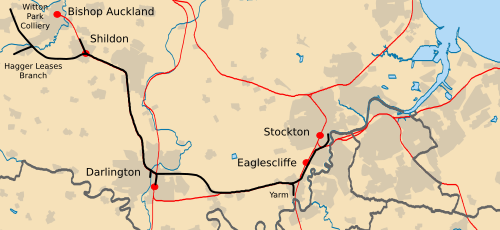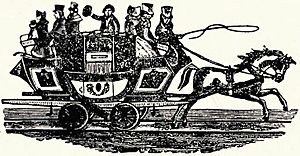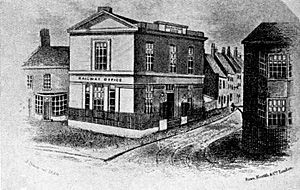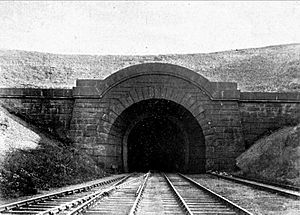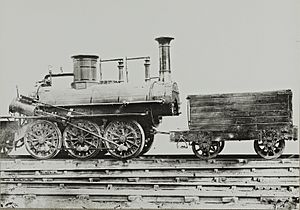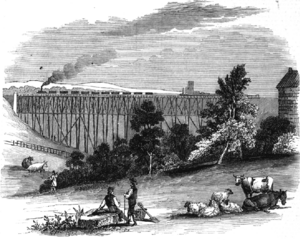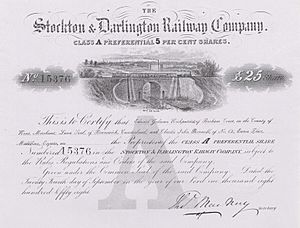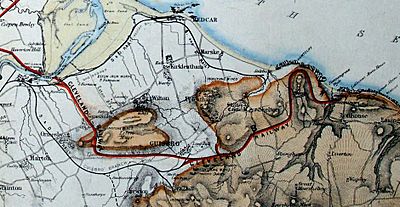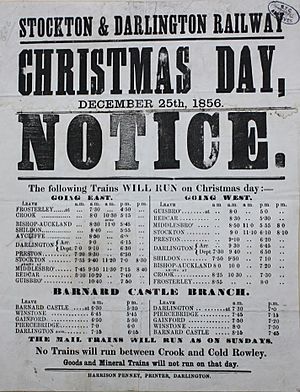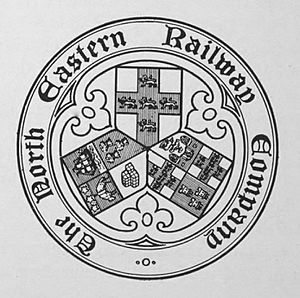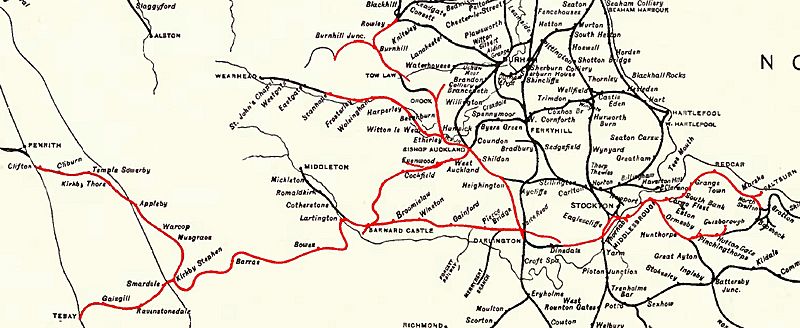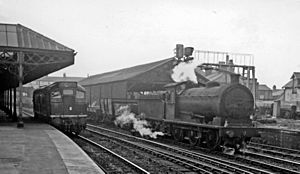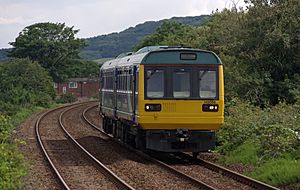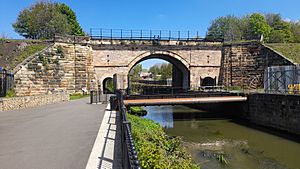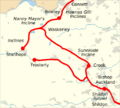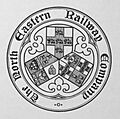Stockton and Darlington Railway facts for kids

Map of the original planned route of the railway, taken from the prospectus of 1821
|
|
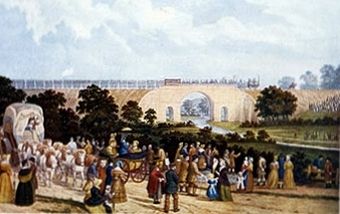
In the Opening of the Stockton and Darlington Railway, a watercolour painted in the 1880s by John Dobbin, crowds are watching the inaugural train cross the Skerne Bridge in Darlington.
|
|
| Overview | |
|---|---|
| Locale | County Durham |
| Dates of operation | 1825–1863 |
| Successor | North Eastern Railway |
The Stockton and Darlington Railway (S&DR) was a railway company in north-east England. It ran from 1825 to 1863. This railway was the world's first public railway to use steam locomotives.
Its first line connected coal mines near Shildon with Darlington and Stockton-on-Tees. The railway officially opened on September 27, 1825. Moving coal by train to ships quickly became a very profitable business. The line soon extended to a new port at Middlesbrough.
At first, steam locomotives pulled coal wagons. However, horses pulled passenger coaches until 1833. That year, steam locomotives began pulling passenger carriages too. The S&DR helped build the East Coast Main Line between York and Darlington. It also expanded its lines to Middlesbrough Docks, west into Weardale, and east to Redcar.
The company faced big money problems in the late 1840s. It was almost taken over by another railway. But then, iron ore was found in Cleveland. This brought in much more money, allowing the S&DR to pay its debts. In the early 1860s, the S&DR took over railways that crossed the Pennines. These lines connected to the West Coast Main Line at Tebay and Clifton.
The North Eastern Railway took over the S&DR in 1863. This included 200 miles of track and about 160 locomotives. The S&DR continued to operate somewhat on its own until 1876. The opening of the S&DR proved that steam railways worked well. Its anniversaries were celebrated in 1875, 1925, and 1975. Today, much of the original route is part of the Tees Valley Line. Northern operates trains on this line.
Contents
How the Railway Started
Early Ideas for Transport
Inland coal mines in southern County Durham needed a way to move their coal. At first, they used packhorses. Later, they used horse and carts as roads got better. People suggested building a canal in 1767 and again in 1815. But both plans failed.
The port of Stockton-on-Tees spent a lot of money in the early 1800s. They straightened the River Tees to make it easier for ships. Then, they looked for ways to increase trade to get their money back.
A few years later, a new canal route was suggested. It would go around Darlington and Yarm. People in Yarm met to oppose this plan. They asked engineer George Overton for advice. He suggested building a tramroad, which is like a railway.
Overton surveyed a route from the Etherley and Witton Collieries to Shildon. It would then pass north of Darlington to reach Stockton. The Scottish engineer Robert Stevenson also liked the idea of a railway. Edward Pease, a Quaker, supported it at a public meeting in Darlington. He promised a five percent return on money invested.
About two-thirds of the shares were sold locally. Quakers from other parts of the country bought the rest. A special bill was sent to Parliament in March 1819. But the route went through land owned by Earl of Eldon and Earl of Darlington. They opposed it, and the bill was defeated.
Overton surveyed a new line that avoided Darlington's land. An agreement was reached with Eldon. But another application was put off in 1820. This was because King George III had died, making it hard for bills to pass. The railway promoters tried again on September 30, 1820. The route had changed again because they couldn't agree with Viscount Barrington.
This time, no one opposed the railway. But the bill almost failed because not enough shares had been sold. Pease invested £7,000. From then on, he had a lot of say in the railway. It became known as "the Quaker line." The law was approved on April 19, 1821. It allowed anyone to use the railway with their own vehicles if they paid a fee. It was closed at night. Landowners within 5 miles could build their own branch lines. The law did not mention steam locomotives.
George Stephenson's Role
Pease was worried about Overton's skills. He asked George Stephenson, an experienced engine builder from Killingworth collieries, to meet him. On May 12, 1821, shareholders chose Thomas Meynell as chairman. Jonathan Backhouse became treasurer. Most of the managing committee were Quakers. This included Thomas Richardson, Edward Pease, and his son Joseph Pease.
The committee designed a seal. It showed wagons pulled by a horse. Their motto was Latin: Periculum privatum utilitas publica. This means "At private risk for public service." By July 23, 1821, they decided the line would be a railway with edge rails. This was instead of a plateway. They hired Stephenson to survey the line again. Stephenson suggested using strong iron rails. He owned a patent for cast iron rails, but still recommended the better ones. Both types were used.
Stephenson's 18-year-old son Robert helped him with the survey. By the end of 1821, Stephenson reported that a good line could be built. But he found another route that was 3 miles shorter. It also avoided deep cuts and tunnels. Overton was no longer involved. Shareholders elected Stephenson as Engineer on January 22, 1822. He earned £660 per year.
On May 23, 1822, a ceremony in Stockton celebrated the laying of the first track. The rails were 4 feet 8.5 inches apart. This was the same width Stephenson used on his Killingworth Railway. This width later became the standard gauge for most railways worldwide.
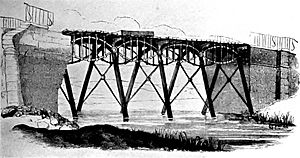
Stephenson believed steam locomotives should be used on the line. Pease visited Killingworth in mid-1822. The directors then visited Hetton colliery railway. Stephenson had already introduced steam locomotives there. A new bill was presented to Parliament. It asked for Stephenson's new route and the use of "loco-motives or moveable engines." This bill was approved on May 23, 1823.
The line included embankments up to 48 feet high. Stephenson designed an iron bridge to cross the River Gaunless. The Skerne Bridge over the River Skerne was designed by architect Ignatius Bonomi.
In 1823, Stephenson and Pease opened Robert Stephenson and Company. This was a locomotive factory in Newcastle. The next year, the S&DR ordered two steam locomotives and two stationary engines from them. On September 16, 1825, the first locomotive, Locomotion No. 1, left the factory. The next day, it was announced that the railway would open on September 27, 1825.
Opening Day
Building the railway cost much more than expected. By September 1825, the company had borrowed £60,000. They needed to start earning money to pay back their lenders. A railway coach called Experiment arrived on September 26, 1825. It was attached to Locomotion No. 1. The locomotive had just arrived at Aycliffe Lane station by road from Newcastle.
Pease, Stephenson, and other committee members took a test trip to Darlington. Then they took the locomotive and coach to Shildon. This was to get ready for opening day. James Stephenson, George's older brother, was driving. On September 27, between 7 and 8 AM, 12 wagons of coal were pulled up Etherley North Bank. A rope attached to a stationary engine at the top did this. Then, they were let down the South Bank to St Helen's Auckland.
A wagon of flour bags was added. Horses pulled the train across the Gaunless Bridge. It went to the bottom of Brusselton West Bank. Thousands of people watched the second stationary engine pull the train up the incline. The train was then let down the East Bank to Mason's Arms Crossing. There, Locomotion No. 1, Experiment, and 21 new coal wagons with seats were waiting.
The directors had planned for 300 passengers. But the train left with 450 to 600 people. Most rode in empty wagons. Some even sat on top of wagons full of coal. Brakesmen were placed between the wagons. The train started, led by a man on horseback with a flag. It sped up on the gentle downhill slope. It reached 10 to 12 miles per hour. Men on horses trying to keep up were left behind.
The train stopped when a wheel fell off the wagon carrying surveyors. That wagon was left behind, and the train continued. It stopped again for 35 minutes to fix the locomotive. The train then started again, reaching 15 mph. About 10,000 people welcomed it as it stopped at the Darlington branch junction. It had covered 8.5 miles in two hours. Taking out the 55 minutes of stops, it averaged 8 mph. Six wagons of coal were given to the poor. Workers stopped for food. Many passengers got off at Darlington, and others got on.
Two wagons for the Yarm Band were attached. At 12:30 PM, the locomotive left for Stockton. It was now pulling 31 vehicles with 550 passengers. On the 5 miles of nearly flat track east of Darlington, the train struggled. It could not go faster than 4 mph. At Eaglescliffe near Yarm, crowds waited for the train. It crossed the Stockton to Yarm road.
As it neared Stockton, it ran next to the road. It skirted the western edge of Preston Park. It gained speed and reached 15 mph again. Then, a man clinging to a wagon fell off. His foot was crushed by the next vehicle. Work on the last section of track to Stockton's quayside was still ongoing. So, the train stopped at a temporary passenger stop. This was at St John's Well, 3 hours and 7 minutes after leaving Darlington. The opening ceremony was a success. That evening, 102 people had a celebration dinner at the Town Hall.
Early Days of Operation
The railway that opened in September 1825 was 25 miles long. It ran from Phoenix Pit, Old Etherley Colliery, to Cottage Row, Stockton. There was also a 0.5-mile branch to Darlington and a 0.75-mile branch to Yarm. Most of the track used 28 lb/yd iron rails. Four miles of heavier 57.5 lb/yd cast iron rails were used at junctions.
The line had a single track with four passing loops every mile. Square sleepers supported each rail separately. This allowed horses to walk between them. Stone was used for sleepers west of Darlington, and oak to the east. Stephenson preferred all stone, but it was too expensive to transport.
The railway opened owing money and couldn't get more loans. Pease lent money twice in early 1826 so workers could be paid. By August 1827, the company had paid its debts. It could then raise more money. That month, the Black Boy branch opened. Construction began on the Croft and Hagger Leases branches. During 1827, shares rose from £120 to £160.
The line was first used to carry coal to Darlington and Stockton. It carried 10,000 tons in the first three months. This earned nearly £2,000. In Stockton, the price of coal dropped from 18 shillings to 12 shillings. By early 1827, it was 8 shillings 6 pence.
At first, drivers were paid daily. After February 1826, they were paid 0.25 pence per ton per mile. From this, they paid assistants and bought coal for the locomotive. The 1821 law had limits on coal transport rates. This was to avoid competition with coal owners on the River Wear. But the business was still profitable. London wanted 100,000 tons a year.
In January 1826, the first coal loading dock opened at Stockton. It was designed to unload coal from the bottom of wagons into ships. About 18,500 tons of coal went to ships by June 1827. This increased to over 52,000 tons the next year. This was 44.5% of all coal carried.
The locomotives were not always reliable at first. Locomotion No. 1 broke a wheel soon after opening. It was not ready until October 12 or 13. Hope, the second locomotive, arrived in November 1825. But it needed a week to get ready. Its cast-iron wheels caused problems. Two more similar locomotives arrived in 1826. By the end of 1827, the company also bought Chittaprat and Experiment.
Timothy Hackworth, the locomotive manager, used the boiler from Chittaprat. He built the Royal George at the Shildon works. It started work in November. Some claimed locomotives would have been abandoned without Hackworth. But historians say the company already knew locomotives were better than horses. Locomotives moved coal at half the cost of horses.
New locomotives were ordered from Stephenson's. But the first one in February 1828 was too heavy. It was rebuilt with six wheels and was a big improvement. Hackworth was told to convert other locomotives quickly. In 1828, two locomotive boilers exploded. Both killed the driver. This was because safety valves were left closed while the engine was stopped.
Horses were also used on the line. They could pull up to four wagons. The dandy waggon was introduced in mid-1828. This was a small cart at the end of the train. It carried the horse downhill, letting it rest. The S&DR made them required from November 1828.
Passenger service started on October 10, 1825. It used the Experiment coach pulled by a horse. The coach was scheduled to go from Stockton to Darlington in two hours. The fare was 1 shilling. It made a round trip four days a week. It also made a one-way trip on Tuesdays and Saturdays. In April 1826, the coach operation was contracted for £200 a year. The trip time was cut to 1 hour 15 minutes. Passengers could ride outside for 9 pence.
A more comfortable coach, Express, started the same month. It charged 1 shilling 6 pence for inside travel. Innkeepers began running coaches. Two went to Shildon from July. The Union served the Yarm branch from October 16. There were no stations. In Darlington, coaches picked up passengers near the north road crossing. In Stockton, they picked up at different places on the quay. Between 30,000 and 40,000 passengers were carried from July 1826 to June 1827.
Middlesbrough's Start
Exporting coal became the railway's main business. But the docks at Stockton were too small. Also, the size of ships was limited by the depth of the Tees River. In 1826, a branch line from Stockton to Haverton was suggested. This was on the north bank of the Tees. Engineer Thomas Storey suggested a shorter, cheaper line to Middlesbrough in July 1827. This was south of the Tees. George Stephenson approved this plan. Shareholders agreed on October 26.
The Tees Navigation Company was about to improve the river. They asked the railway to delay their plan. But despite opposition, it was decided to go ahead in January 1828. A more direct route from Auckland to the Tees had been considered since 1819. The Tees & Weardale Railway had tried to get permission for such a line.
This new plan became an 11.5-mile line. It linked Simpasture on the S&DR's line near today's Newton Aycliffe station with Haverton and Stockton. This route was 6 miles shorter than the S&DR's main line. It was named the Clarence Railway after the Duke of Clarence.
Meetings in Stockton in early 1828 supported the Tees Navigation and Clarence Railway. But the S&DR got permission for its branch on May 23, 1828. They promised to finish the Hagger Leases Branch. They also promised to build a bridge across the Tees. It would be at least 72 feet wide and 19 feet above low water. This was so it wouldn't affect shipping. Two management committee members resigned. They felt Stockton would be harmed by the new line. Meynell, the S&DR chairman, also stepped down.
The Clarence Railway was approved a few days later. It had the same track width as the S&DR. The Clarence Railway route was later changed. It reached Samphire Batts, now Port Clarence. Traffic started in August 1833. By mid-1834, Port Clarence had opened, and 28 miles of line were in use. The S&DR charged a higher rate for coal going to Port Clarence. By July 1834, the Exchequer Loan Commissioners controlled the Clarence Railway.
The Croft branch opened in October 1829. Building the suspension bridge across the Tees started in July 1829. But it stopped in October. The Tees Navigation Company said the S&DR had no permission to cross the Old Channel of the Tees. The S&DR prepared to go back to Parliament. But they stopped after agreeing on a drawbridge design with the Navigation Company.
The line to Middlesbrough used 33 lb/yd iron rails. These rested on oak blocks. The suspension bridge was designed to carry 150 tons. But the iron plates broke when tested with only 66 tons. So, loaded trains had to cross with wagons split into groups of four. These were linked by a 9-yard chain.
For the opening ceremony on December 27, 1830, a new locomotive called "Globe" was used. Hackworth designed it for passenger trains. It pulled people in carriages and wagons with seats across the bridge. They went to the docks at Port Darlington, which had space for six ships. Stockton continued to have a station on the line to the quay until 1848. Then, a new station on the Middlesbrough line replaced it.
Before May 1829, Thomas Richardson bought about 500 acres near Port Darlington. With Joseph and Edward Pease, he formed the Owners of the Middlesbrough Estate. They developed the area. Middlesbrough had only a few houses before the railway. A year later, it had over 2,000 people. By 2011, it had over 138,000 people.
Railway Improvements
In 1830, the company opened new offices in Darlington. Between 1831 and 1832, a second track was added between Stockton and Brusselton Bank. Workshops were built at Shildon to maintain and build locomotives. In 1830, about 50 horses shared traffic with 19 locomotives. But they traveled at different speeds. To help traffic flow, horse-drawn trains had to operate in groups of four or five.
Sometimes, horses were startled by a passing locomotive. They would come off their dandy cart and be hit by the next train. Once, a driver fell asleep in his dandy cart. His horse stopped and was hit by a locomotive. The rules said locomotive trains had priority. But some horse drivers refused to move. Once, a locomotive had to follow a horse train for over 2 miles.
In 1828, the committee decided to replace horses with locomotives on the main line. They started with coal trains. But some coal mine owners resisted. The S&DR bought out the coach companies in August 1832. A mixed passenger and small goods service began between Stockton and Darlington on September 7, 1833. It traveled at 12–14 mph. Locomotive services started to Shildon in December 1833. They reached Middlesbrough on April 7, 1834.
The company had paid the five percent dividend Edward Pease promised. This increased to eight percent by the time he retired in 1832. When treasurer Jonathan Backhouse retired in 1833, Joseph Pease replaced him.
Connecting North
Great North of England Railway
On October 13, 1835, the York and North Midland Railway (Y&NMR) was formed. It aimed to connect York to London. Representatives from Y&NMR and S&DR met two weeks later. They formed the Great North of England Railway (GNER). This line would go from York to Newcastle. It would use the 1.5-mile Croft branch at Darlington.
The railway would be built in sections. Permission for the harder line through the hills from Darlington to Newcastle was sought in 1836. A bill for the easier line south of Darlington to York was presented the next year. Pease wanted the line wide enough for four tracks. This would allow freight at 30 mph and passengers at 60 mph. George Stephenson had detailed plans by November.
The law for the 34.5-mile line from Newcastle to Darlington was approved on July 4, 1836. But little work was done. The 43-mile line from Croft to York got permission on July 12, 1837. In August, it was decided to start work on the southern section. But construction was delayed. Several bridges collapsed. Engineer Thomas Storey was replaced by Robert Stephenson. The S&DR sold its Croft branch to the GNER. The railway opened for coal traffic on January 4, 1841. It used S&DR locomotives. It opened to passengers with its own locomotives on March 30.
Between November 1841 and February 1842, the S&DR started a service. It ran between Darlington and Coxhoe on the Clarence Railway. An omnibus then took passengers 3.5 miles to the Durham & Sunderland Railway at Shincliffe. In early 1842, the Shildon Tunnel Company opened its 1225-yard tunnel. It went through the hills at Shildon to the Wear basin. After laying 2 miles of track to South Church station, it opened in May 1842.
In 1846, the S&DR installed Alexander Bain's electric telegraph. This helped control trains through the tunnel. The S&DR offered a 3.25-hour service between Darlington and Newcastle. An omnibus went from South Church to Rainton Meadows. From there, trains ran to Gateshead, near Newcastle.
Railway Operations in the 1830s
By 1839, the track was improved with heavier rails. The railway had about 30 steam locomotives. Most had six wheels. They ran with four-wheeled tenders. These tenders had two water tanks, each holding 600 gallons. The line went downhill from Shildon to Stockton. This helped coal trains going to the docks. The maximum speed was 6 mph. Drivers were fined if they went faster than 8 mph. One was fired for finishing a 40-mile round trip in 4.5 hours.
On average, there were about 40 coal trains a day. They hauled 28 wagons weighing 116 tons. There were about 5,000 privately owned wagons. About 1,000 were usually at the Shildon depot.
The railway had modern passenger locomotives. Some had four wheels. There were passenger stations at Stockton, Middlesbrough, Darlington, Shildon, and West Auckland. Trains also stopped at Middlesbrough Junction, Yarm Junction, Fighting Cocks, and Heighington. Some modified road coaches were still used. But there were also modern railway carriages. Some first-class carriages had three sections, each seating eight passengers. Second-class carriages seated up to 40.
Luggage and sometimes the guard traveled on the carriage roof. A third-class passenger was seriously hurt after falling from the roof in 1840. Passenger trains averaged 22–25 mph. A speed of 42 mph was recorded. Over 200,000 passengers were carried in the year to October 1, 1838. In 1839, there were twelve trains daily between Middlesbrough and Stockton. Six trains ran between Stockton and Darlington. Three ran between Darlington and Shildon.
At Shildon, a carriage with Rankine's self-acting brake was used. It went over the Brussleton Inclines. Then a horse pulled it to St Helen Auckland. Bradshaw's railway guide for March 1843 showed five daily services between Darlington and South Church. Three ran between Shildon and St Helens. Also listed were six trains between Stockton and Hartlepool via Seaton. These ran over the Clarence Railway and the Stockton and Hartlepool Railway.
By this time, Port Darlington was too busy for all the goods. Work started in 1839 on Middlesbrough Dock. William Cubitt designed it to hold 150 ships. George Turnbull built it. The suspension bridge across the Tees was replaced by an iron bridge in 1841. The new dock officially opened on May 12, 1842. It cost £122,000. The S&DR paid most of the cost. The company took over the dock in 1849.
Newcastle and Darlington Junction Railway
The GNER had permission for a railway from York to Newcastle. It opened to Darlington in 1841. But it had spent all its money and couldn't extend to Newcastle. At the time, Parliament was deciding on a railway route between England and Scotland. They preferred a route through the west coast.
Railway financier George Hudson led a meeting of north-eastern railways. They wanted a railway built through the east coast. In the 1830s, several railways had opened between Darlington and Newcastle. Robert Stephenson was hired to choose a route using these railways as much as possible. The Newcastle and Darlington Junction Railway (N&DJR) was slightly different from the GNER route. It joined the Durham Junction Railway at Rainton. It then used the Pontop & South Shields Railway to Brockley Whins. A new curve allowed direct access to Gateshead.
This required building 25.5 miles of new line. This was 9 miles less than the GNER route. But trains would have to travel 7.5 miles further. This route ran parallel to S&DR lines for 5 miles. Pease argued it should run over these lines. He said it would only add 1.5 miles. The bill was presented to Parliament in 1842 without changes. The S&DR opposed it.
Despite this, the Newcastle and Darlington Junction Railway Act was approved on June 18, 1842. A second Act the next year secured the changes Stephenson suggested. After the opening celebration on June 18, 1844, trains ran from London to Gateshead the next day.
The N&DJR offered to lease the GNER and buy it within five years. GNER shares increased by 44 percent. The N&DJR took over on July 1, 1845. The N&DJR became part of the larger York, Newcastle and Berwick Railway (YN&BR) in 1847.
Wear Valley Railway
The Bishop Auckland & Weardale Railway (BA&WR) got permission in July 1837. It was to build an 8.25-mile line from South Church to Crook. The line opened on November 8, 1843, with a station at Bishop Auckland.
The Stanhope and Tyne Railway was a 33.75-mile line. It ran between South Shields and Stanhope. It opened in 1834. Steam locomotives worked the eastern part. In the western part, stationary engines or gravity worked inclines. Horses pulled wagons on flat sections. The lime kilns and the line between Stanhope and Carrhouse closed in 1840. The Stanhope to Annfield section was losing money. The railway company was dissolved on February 5, 1841.
The northern section became the Pontop and South Shields Railway. The southern section from Stanhope to Carrhouse was bought by the Derwent Iron Company. It was renamed the Wear & Derwent Railway. It transported limestone from quarries to its works at Consett. The Weardale Extension Railway ran from Waskerley to Crook. It included the Sunniside Incline. The S&DR built the 10-mile line. It opened on May 16, 1845.
A passenger service started to Hownes Gill and Stanhope (Crawley) on September 1, 1845. The Stanhope service stopped at the end of 1846. Traveling north from Crook, carriages were pulled up the Sunniside Incline. A locomotive then pulled the train to Waskerley Park Junction. Then they were let down Nanny Mayor's Incline. A locomotive took them forward.
When returning, carriages ran loose down the Sunniside Incline. They ran into Crook station, controlled by the guard. Later, a 730-foot viaduct replaced two inclines at Hownes Gill ravine. This opened on July 1, 1858. A new line replaced Nanny's Mayor's Incline. It also allowed direct access to Rowley. It opened for freight on May 23, 1859, and for passengers on July 4, 1859.
The Middlesbrough & Redcar Railway was a short extension to Redcar. It got permission on July 21, 1845. The line branched off before the Middlesbrough end. The old Middlesbrough station closed. A new through station opened with the line on June 4, 1846. Also approved in July 1845 was the Wear Valley Railway. This was a 12-mile line from the Bishop Auckland & Weardale line to Frosterley.
The line opened on August 3, 1847. The law also gave the S&DR permission for the Bishopley branch. Over 500,000 tons of limestone traveled on it in 1868. The line was extended in 1862 from Frosterley to Stanhope.
Just before the line opened on July 22, 1847, the Wear Valley Railway absorbed other lines. These included the Shildon Tunnel, Bishop Auckland & Weardale Railway, and others. Then the S&DR leased the Wear Valley Railway and Middlesbrough & Redcar Railways for 999 years. This required a payment of £47,000 each year. This was more than the S&DR's income. Traffic from the Derwent Iron Company dropped. The Black Boy colliery sent its coal to Hartlepool instead.
No dividend was paid in 1848 and the next few years. Lease payments were made from savings. The S&DR announced a bill in November 1848. It would allow a merger with the YN&BR. But this was withdrawn after the YN&BR share price crashed. Its chairman Hudson resigned due to questions about his share dealings. In 1850, the S&DR had £250,000 in shares but owed £650,000. Most of this debt was converted into shares in 1851.
Cleveland Iron Ore Discovery
In mid-1850, Henry Bolckow and John Vaughan found a large amount of iron ore at Eston. They opened a mine there. They built a branch line to the Middlesbrough & Redcar Railway. They started moving ironstone over the S&DR to their blast furnaces west of Bishop Auckland. By 1851, Derwent Iron had opened a mine in the area. They began moving ironstone 54 miles to Consett. The S&DR paid its debts and could pay a dividend the next year. It was only 4 percent. Between 1849 and 1853, traffic more than doubled.
In 1852, the Leeds Northern Railway (LNR) built a line from Northallerton. It connected to the Stockton to Hartlepool line. A section ran parallel to the S&DR. The S&DR was originally on the east side of the road. But the LNR built its line with four tracks on the other side. It leased two to the S&DR for 1 shilling a year. On January 25, 1853, the LNR and S&DR opened a joint station at Eaglescliffe. It had an island platform between the tracks. One side was used by S&DR trains, the other by the LNR.
The Board of Trade ruled that trains approaching on a line without a platform had to pass through. Then they had to reverse into the platform line.
The Middlesbrough & Guisborough Railway was approved on June 17, 1852. It had two branches into the iron-rich hills. Pease had to guarantee dividends to raise the money. The 9.5-mile single-track railway was operated by the S&DR. It opened for minerals on November 11, 1853. It opened for passengers on February 25, 1854. With electric telegraph between stations, passenger trains could not leave until the line was clear.
By 1857, a blast furnace opened near the Durham coalfield. It was on the north side of the Tees. The West Hartlepool Harbour & Railway backed the Durham & Cleveland Union Railway. They proposed a line from mines in Skinningrove and Staithes. It would go via Guisborough and a bridge over the Middlesbrough & Redcar Railway. It would end at a jetty at Cargo Fleet. A ferry would carry the ore across the Tees to the blast furnaces.
When the proposal was in Parliament, the S&DR suggested extending their Middlesbrough & Redcar line to Saltburn. They also suggested a swing bridge over the Tees. The Cleveland Railway got permission for a line from Skinningrove to Guisborough. The S&DR got permission for an extension to Saltburn. They also got a branch to a mine at Skelton. This 1858 S&DR Act also allowed the S&DR to merge with the railways it leased.
An application to Parliament for a jetty the next year failed. But in 1860, the Upsall, Normanby & Ormesby Railway got permission for a line with river access. The S&DR's claim of exclusive rights to the foreshore was rejected. The jetty was also opposed by the Tees Conservancy Commissioners. They moored barges along the foreshore to block construction.
In what became known as the Battle of the Tees, a fight broke out. A steam tug from the Commissioners interrupted men moving the barges. The barges were moved. But a more serious fight happened the next night. Three of the Commissioners' steam tugs arrived. The police then watched the works until they were finished.
Henry Pease, an S&DR director, visited his brother Joseph in mid-1859. Joseph had a house by the sea at Marske-by-the-Sea. Henry was late for dinner. He explained he had walked to Saltburn, then a group of fisherman's cottages. He had a "prophetic vision" of a town with gardens. With other S&DR directors, he planned the town. It had gardens and the Zetland Hotel by the station. He bought a house at 5 Britannia Terrace. He stayed there a few weeks every summer. The extension opened in 1861. A station on the through line replaced the old Redcar station.
Across the Pennines
A railway to serve Barnard Castle was proposed in 1852. It would go from the S&DR near North Road station. It would follow the River Tees. This route avoided the Duke of Cleveland's land as much as possible. He had opposed an earlier railway. An application that year failed. But the Darlington & Barnard Castle Railway Act was approved on July 3, 1854. The 15.25-mile railway opened on July 8, 1856.
Cleveland iron ore has a lot of phosphorus. It needs to be mixed with purer ores. These are found on the west coast in Cumberland and Lancashire. In the early 1850s, this ore traveled a long way. It went over the Newcastle & Carlisle Railway to the Barrow-in-Furness area. Durham coke was returned.
Both the South Durham & Lancashire Union Railway (SD&LUR) and the Eden Valley Railway (EVR) companies formed on September 20, 1856. The SD&LUR used the new railway at Barnard Castle. It crossed the Pennines via Kirkby Stephen. It met the West Coast Main Line (WCML) at Tebay. It also linked Barnard Castle with West Auckland. The EVR was a branch from Kirkby Stephen to the WCML near Penrith. It went via Appleby.
Thomas Bouch surveyed the routes. The SD&LUR got permission on July 13, 1857. The EVR route followed the east bank of the River Eden. It was a mile longer than a more expensive route. Its Act was approved on May 21, 1858.
Bouch designed an economical route. It followed the land's curves and avoided tunnels. But there were steep slopes up to the 1370-foot Stainmore Summit. Land for two tracks was bought, but only a single track was laid. Viaducts crossed valleys. Three were made from wrought iron. This included the Belah Viaduct, 1040 feet long and 196 feet high. A new station replaced the old one at Barnard Castle.
A mineral train ran between Barnard Castle and Barras on March 26, 1861. Mineral traffic worked through to Tebay from July 4, 1861. There was an opening ceremony on August 7, 1861. The SD&LUR west of Barnard Castle opened to passengers the next day. Two 4-4-0 locomotives were built for the line in 1860 by Stephenson and Co. The S&DR operated traffic from the start. Two round trips a day were provided for passengers.
The EVR opened to mineral traffic on April 8, 1862. It opened to passengers on June 9, 1862. It went to the south-facing junction at Clifton. The S&DR had presented a bill in 1861. It aimed to provide better connections for WCML passengers. This was by extending the line to Penrith. It also aimed to link with the Cockermouth, Keswick and Penrith Railway. This would give mineral traffic access to Cumberland. The L&CR allowed the S&DR to use its line. Services were extended to Penrith from August 1, 1863.
Growth and Mergers
In 1854, there were five or six trains daily between Darlington and Redcar. Three trains ran daily between Darlington and Frosterley. They traveled at average speeds of 19–24 mph. Passengers paid from 1 pence per mile for third class to 2.2 pence per mile for first class. Horses were still used on trains in the mid-1850s. A horse-drawn coach ran independently between Middlesbrough and Stockton on Sundays in 1854. This was because the only S&DR services on Sundays were mail trains. Locomotives replaced horses on passenger trains to West Auckland in 1856.
The S&DR opened a carriage works south of Darlington North Road station in 1853. Later, it built a locomotive works nearby. This replaced its works at Shildon. William Bouch designed it. He had taken over from Hackworth in 1840. It completed its first locomotive in 1864. In 1858, the Brusselton Inclines were bypassed. A line from the north end of Shildon Tunnel did this. The same year, a passenger service started on the Hagger Leases branch. A mineral line opened from Crook to Waterhouse. The SD&LUR section between West Auckland and Barnard Castle opened for minerals in July 1863. It opened for passengers on August 1, 1863. A direct line from Bishop Auckland to West Auckland also opened. Stations at Evenwood and Cockfield replaced stations on the Hagger Leases branch.
In 1859, a company formed to link the Newcastle & Carlisle Railway with the S&DR. It would go via the Derwent Valley. By 1860, this grew into the Newcastle, Derwent & Weardale Railway. This new line bypassed the S&DR. It linked with the SD&LUR. The North British and London and North Western (LNWR) railways provided two-thirds of the money. The LNWR proposed to build warehouses in Hartlepool. They also wanted to buy shares in the West Hartlepool Harbour & Railway.
The North Eastern Railway (NER) formed in 1854. It was the largest railway company in the country. It controlled the East Coast Main Line from Knottingley to Berwick-upon-Tweed. When they approached the S&DR about merging, the directors preferred it. They didn't want to become part of the LNWR. So, they started talks. The NER opposed the Newcastle, Derwent & Weardale Railway bill. But it was approved by the House of Commons in 1861. However, the line was rejected by the House of Lords. The SD&LUR and EVR were absorbed by the S&DR on June 30, 1862.
With 200 miles of line and about 160 locomotives, the Stockton and Darlington Railway became part of the North Eastern Railway on July 13, 1863. Because of a rule in the law, the railway was managed as the independent Darlington Section until 1876. Then, the lines became the NER's Central Division. After the dividend was restored in 1851, payments recovered to 8 percent by the end of 1854. They did not drop below 7.5 percent after that.
Later History
The NER built a branch from Durham to Bishop Auckland in the late 1850s. But it used a separate station until December 1867. Then, all services used the S&DR station. The Sunniside Incline was replaced by a new line. It had steep slopes of 1 in 51 and 1 in 52. It opened for mineral traffic on April 10, 1867. It opened for passengers on March 2, 1868. After 1868, trains on this line extended to serve Benfieldside station (later Consett).
In Cleveland, a branch from Nunthorpe to Battersby opened on June 1, 1864. Passengers were carried from April 1, 1868. A branch from Barnard Castle to Middleton-in-Teesdale opened on May 12, 1868.
The locomotive works at Darlington operated independently until 1875. The NER had renumbered the locomotives a few years earlier. There were many types of locomotives. But the most common type for mineral trains had a wheel arrangement of 0-6-0. Later engines were of the Stephenson long boilered type. Most passenger locomotives had four driven wheels, like a 2-4-0. Some were 2-2-2. Bouch designed two 4-4-0 locomotives for the line over Stainmore in 1860. Another fourteen were built by 1874.
S&DR services and those on the ECML used different stations in Darlington until 1887. Then, S&DR trains were rerouted through a rebuilt Darlington Bank Top station. They rejoined the route to Stockton from a junction south of Darlington. An extension from Stanhope to Wearhead opened in 1895. The line over Stainmore to Tebay was doubled by the end of the century.
From 1913, former S&DR lines were electrified. Electric locomotives pulled coal trains between Shildon and Erimus Marshalling Yard. This yard opened in 1908. The trains took the former S&DR line from Shildon to Simpasture Junction. They joined the former Clarence Railway line to Carlton. A later line allowed access to the Stockton to Middlesbrough extension. The locomotives operated for 20 years. But then coal traffic decreased. It became too expensive to keep the electric system.
Because of the Railways Act 1921, the North Eastern Railway became part of the London and North Eastern Railway (LNER) on January 1, 1923. Passenger service north of Tow Law stopped on May 1, 1939. Britain's railways were nationalized on January 1, 1948. The lines were controlled by British Railways. In the early 1950s, control was split. Kirkby Stephen was the boundary. Local passenger trains stopped between Kirkby Stephen and Tebay on December 1, 1952. Service along Weardale stopped on June 29, 1953. Services north of Crook stopped on June 11, 1956.
The 1955 Modernisation Plan aimed to make trains faster and more reliable. Steam trains were replaced with electric and diesel trains. From 1954, diesel multiple units took over passenger services in the north east. They were introduced to the line over Stainmore in February 1958. Passenger service stopped between Barnard Castle and Penrith on January 20, 1962. It stopped between Bishop Auckland and Barnard Castle on June 12, 1962.
In 1963, Richard Beeching published his report. It suggested closing less used stations and lines. This included the remaining former S&DR lines. Only the line between Darlington and Saltburn via Stockton and Middlesbrough was kept. Passenger service between Nunthorpe and Guisborough stopped in 1964. The service between Middlesbrough and Nunthorpe continued. The line between Darlington and Barnard Castle closed to passengers on November 30, 1964. The branch to Middleton-in-Teesdale also closed. Trains stopped north of Bishop Auckland on March 8, 1965. But passenger service to Bishop Auckland was saved.
Locomotives
Accidents and Incidents
- On March 19, 1828, the boiler of locomotive No. 5 exploded. This happened at Simpasture Junction. One fireman died, the other was badly burned. The driver, George Stephenson's older brother, was not hurt.
- On July 1, 1828, the boiler of Locomotion No. 1 exploded. This happened at Aycliffe Lane station. The driver was killed.
- On April 4, 1865, at Hartburn (Stockton), a passenger train crashed. It was going from Darlington to Saltburn. It hit coal wagons that had come loose from another train. This accident led the S&DR to use the block system. This system makes railways safer.
Anniversary Celebrations
The Stockton and Darlington was not the very first railway. A train had carried passengers before. But its opening in 1825 showed that steam railways worked well for public transport. A jubilee was held on September 27 and 28, 1875. This celebrated 50 years since the opening of the world's first steam-operated public railway.
The Darlington North Road workshops had a locomotive exhibition. A statue of Joseph Pease was unveiled in Darlington. His portrait was given to the Darlington Corporation. A special dinner was also held. Fifty years later, centenary celebrations were held in July. This allowed visitors from the International Railway Congress to join. The Duke and Duchess of York (later King George VI and the Queen Mother) opened an exhibition of trains. This was at the new Faverdale Wagon Works in Darlington.
The next day, the royal couple watched a parade of locomotives. It went between Stockton and Oak Tree Junction. It started with a Hetton Colliery locomotive from 1822. It ended with a replica train of ten coal wagons. "The company's coach" was pulled by Locomotive No.1. A petrol engine in a special tender pushed it.
A festival was held in Belle Vue, Manchester on September 27, 1925. This was a Sunday so railway workers could attend. A show demonstrated how transport changed over time. It began with ancient Britons dragging a log. It ended with Stephenson's Rocket. Another parade included Locomotion No.1, pushed by its tender, and more modern locomotives.
On August 31, 1975, a parade was held. This was for the 150th anniversary. It went between Shildon and Heighington. A replica of Locomotion led a procession of locomotives. The prototype high-speed train completed it. In the same year, the National Railway Museum opened in York. It combined exhibits from the old LNER museum in York and the National Transport Museum at Clapham.
Legacy Today
The current Tees Valley Line uses most of the old Stockton and Darlington Railway. It runs between Bishop Auckland and Saltburn. From Bishop Auckland, the line is single track to Shildon. It is double track to Heighington. Then it is single track to the junction with the East Coast Main Line. This section is a Community Rail service called the Bishop line. It is also known as the Heritage Line because of its links to the S&DR.
South of Darlington, trains take the 1887 line. They join the original 1825 route to Stockton at Oak Tree Junction. The line is 8 miles to Eaglescliffe South Junction. There, the 1853 Leeds Northern route is taken through Eaglescliffe station. It goes to Stockton Cut Junction. The line then follows the S&DR route for 19 miles to Saltburn. There are some later changes at Thornaby (1908) and Redcar (1978). The former Middlesbrough & Guisborough Railway line is open. It runs between Guisborough Junction and Nunthorpe. It is part of the Community Rail Esk Valley Line to Whitby.
On June 14, 2007, some original stone sleepers were found. They were used by the railway in 1825. They were found near Lingfield Point during road building. Each stone weighs about 75 pounds. They have holes for the bolts that held the rails. Officials hope to save the stones along a new bicycle path.
As of July 2016, Northern provides two trains per hour. They run between Saltburn and Darlington. Ten trains a day continue to Bishop Auckland. One train per hour leaves Middlesbrough going south to Manchester Airport. Another travels north to Newcastle via Sunderland. There are eighteen trains a day between Middlesbrough and Nunthorpe. Four of these continue to Whitby.
Tees Valley Unlimited wants to improve passenger services. They want two trains an hour all day. This would be on the Darlington to Saltburn and Nunthorpe to Hartlepool routes. They would use new trains. Additional platforms are needed at Darlington station for this. A station serving James Cook University Hospital opened in May 2014. A Hitachi train factory opened in September 2015. It is in Newton Aycliffe. It builds trains for the Intercity Express Programme.
At North Road railway station, the station buildings are Grade II* listed. The station building is now the Head of Steam – Darlington Railway Museum. It focuses on the Stockton & Darlington Railway. It housed Locomotion No. 1 until March 2021. Nearby, the former carriage works are now used for steam locomotive repairs. A little further east is Skerne Bridge. It is the oldest railway bridge in continuous use in the world.
At Shildon is "Locomotion" or National Railway Museum Shildon. It is part of the National Railway Museum. It has old railway vehicles, including Locomotion No. 1. The site includes Timothy Hackworth's house, the Soho Workshop, and old coal drops. The heritage Weardale Railway runs special services. It goes from Bishop Auckland to Eastgate-in-Weardale.
Images for kids
-
Stephenson's iron bridge across the Gaunless River




